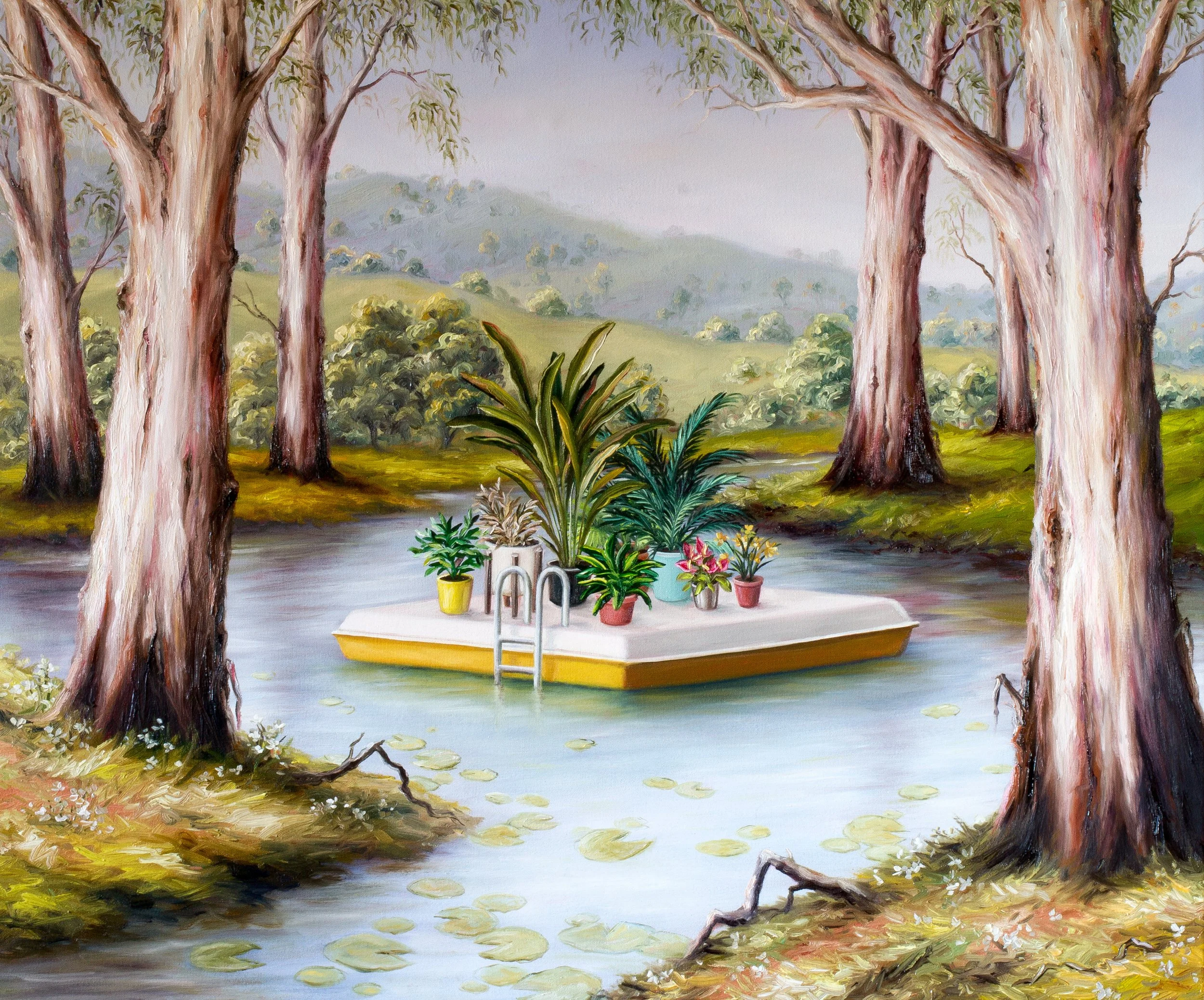Homeland
Devonport Regional Gallery, The Little Gallery Project Space, Devonport
15 July – 27 August 2017
Afloat, 2016, oil on canvas, 76 x 91.5 cm
Shelter, 2016, oil on linen, 84 x 102 cm
Marooned, 2016, oil on canvas, 84 x 102 cm
Winner of the 2018 Ravenswood Australian Women’s Art Prize (Emerging), Gordon
There’s No Place Like Homeland
Written by Miriam McGary
Landscapes can be deceptive. Sometimes a landscape seems to be less a setting for the life of its inhabitants than a curtain behind which their struggles, achievements and accidents take place. For those who are behind the curtain, landmarks are no longer only geographic but also biological and personal.
John Berger [1]
Homeland plays with this potential deception of landscape, through the compilation of contradictory landmarks in imagined sites. The scenes are assemblages of the exotic and the familiar; of Dorothea McKellar’s sunburnt sunsets, Vogue Living pot plants, barren desert plains, citrus fruits, and catalogue shrubbery. The paintings invite us behind the curtain, but rather than providing clarity, Amber disorients and disrupts assumptions of what constitutes an Australian homeland.
In Asunder, Amber ties back the curtain, revealing the performance of landscape. The family of pot plants are the central characters, nestled together in a plastic huddle, and sitting apart from the green habitat. Song of Love and Shelter also feature the curtain, although here is it cast as a shroud in the brooding twilight scenes. The paintings both unveil and cloak the staged environments. Amber invites the viewer backstage in her hybrid arcadia, into the paradoxes and messy contradictions of Australian soil, which consists of contested indigenous, colonial and migrant narratives.
Homeland at once familiarises and dislodges the viewer, making us feel at home in a fictional territory which cannot house us. David Hanson, in discussing John Glover, described the painter’s ‘instinct to domesticate the alien, to domesticate the foreign landscape by reference to home.’[2] Here, Amber flirts with this imperial gaze, and teases mundane home-bound objects into her composite environments to bring a European sense of ‘home’ into the ‘land’. Limp washing up gloves fall across a tree branch, posing as a flowering suburban gumtree, or deflated cockatoo. A plastic flotilla of pot-plants sits adrift in an oasis, and a fruit bowl of oranges is spilled in the tent-like shelter. The glove is a recurring motif in the exhibition: an unintentional riff on John Glover’s name, a reference to de Chirico’s The Love Song, and a sanitised removed hand manipulating the region. Amber echoes de Chirico’s gathering of incongruous objects, to explore a space of belonging, and displacement. These mundane items provide a vocabulary and access point into the depicted non-places, through describing the unfamiliar in familiar terms.
While Amber invites the viewer to feel at home in her landscapes, she also fragments these spaces to disorient and destabalise. Rob Nixon, in discussing the slow violence of displacement, writes:
‘I want to propose a more radical notion of displacement, one that, instead of referring solely to the movement of people from their places of belonging, refers rather to the loss of the land and resources beneath then, a loss that leaves communities stranded in place stripped of the very characteristics that made it habitable.’[3]
The paintings in Homeland both displace and acquaint, through erasing the environment of recognisable landmarks and characteristics, and introducing domestic objects with a gloved hand. These are imagined spaces of no-man’s land, where no-one can belong. In sweeping back the curtain, Amber questions the potential of being ‘home’ in an Australian landscape as a space in between ‘native and introduced species; natural and artificial landscapes, the wild and the tame, the civilised and the non-civilised.’ Rather than these binaries of belonging, the paintings suggest homeland as a site of contestation and hybridity, which is shifting, multiple, and deceptive.
[1] Berger, John (1967) A Fortunate Man: the story of a country doctor Random House, New York
[2] Hanson, David (2003). John Glover and the Colonial Picturesque. Tasmanian Musuem and Art Gallery, Hobart.
[3] Nixon, Rob (2001) Slow Violence and the Environmentalism of the Poor. Harvard University Press, Cambridge.
Work documented by Jack Bett


